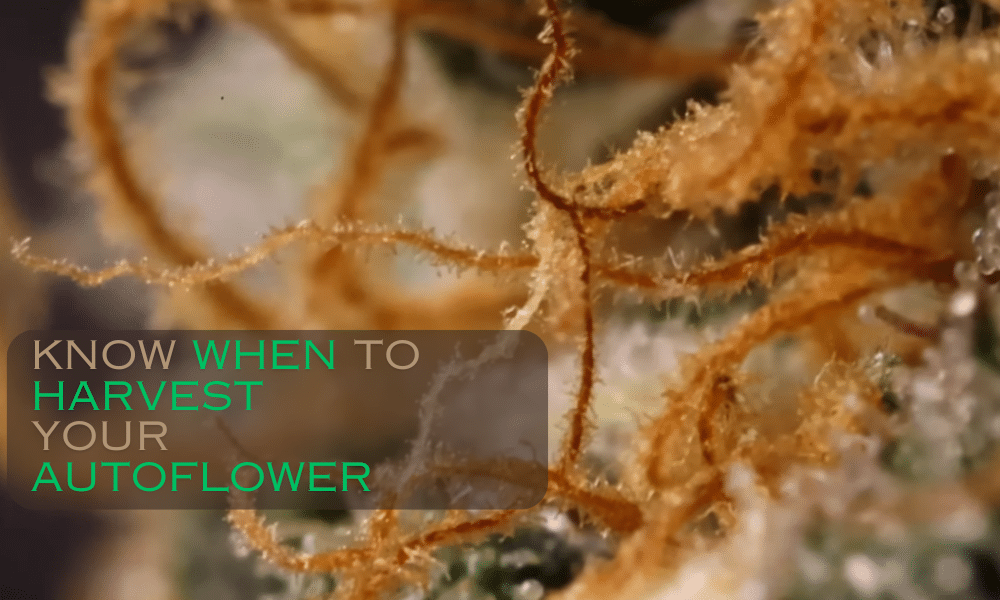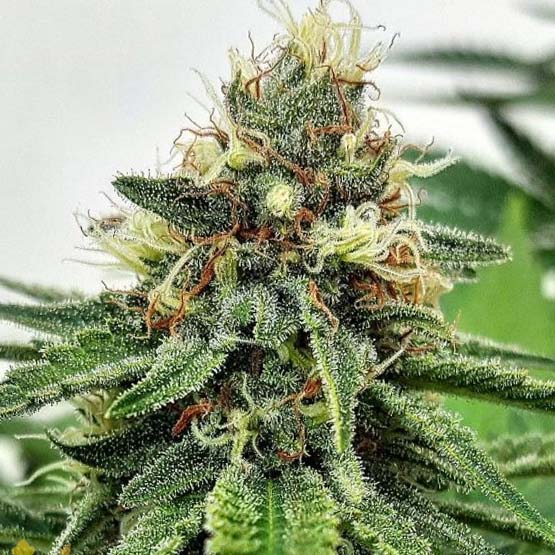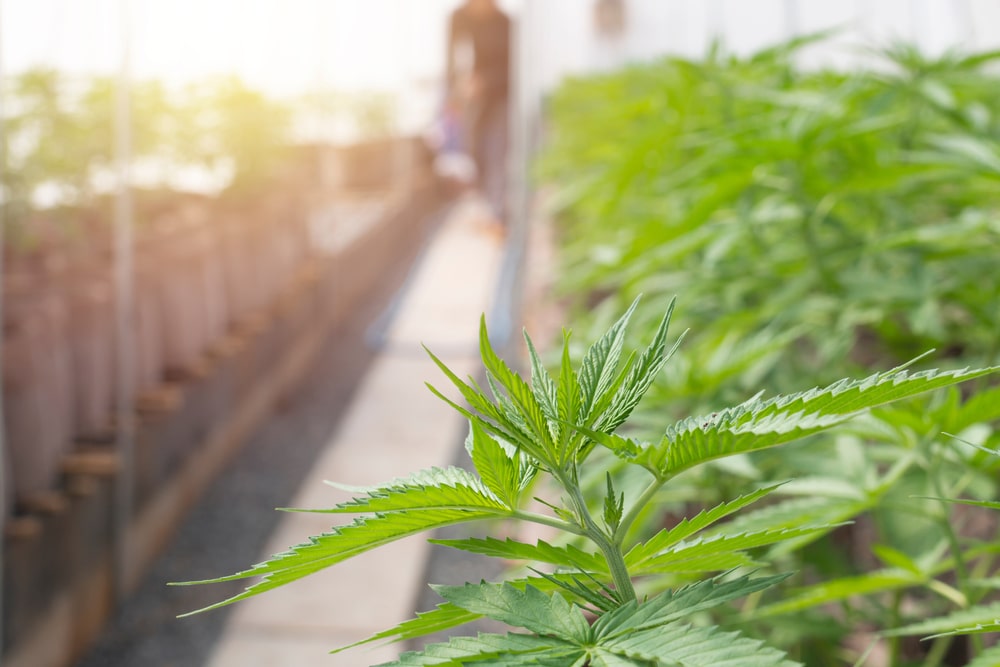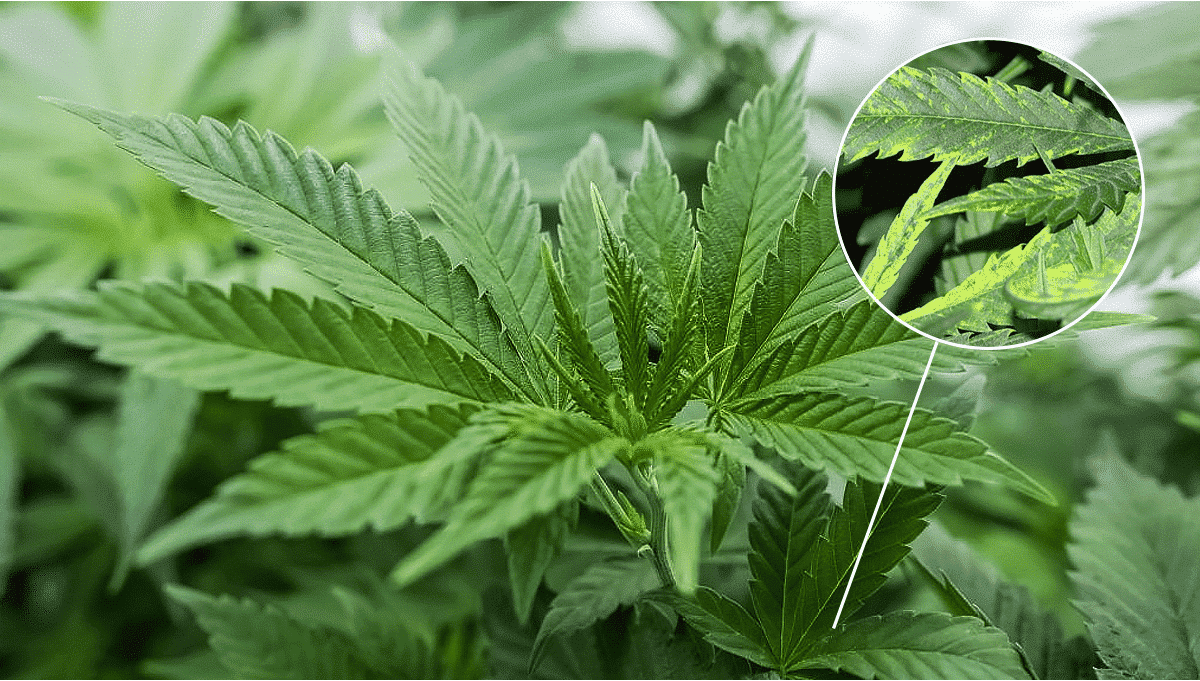No products in the cart.
Marijuana Education
The Best Time to Harvest Autoflowers
There is a best time to harvest autoflowers; the moment right between when your yields peak and when quality starts to decline. Because autoflowers are quick-growing cannabis cultivars, you need to understand autoflower growth stages week-by-week to accurately determine when harvest time is near and the best time to harvest autoflowers.
I’d like to share with you the signs that indicate when it’s time to harvest. While some of these signs are a surefire guarantee that your buds are ready to be harvested, others, contrary to popular belief, may not necessarily indicate ripeness in autoflowers. Many beginners, fearing overripe buds, often harvest too early – I’ll guide you on how to avoid this mistake. This guide details the autoflower growth stages and the right tips and tricks for getting bigger buds for autoflowers at harvest time.
How Long Does it Take for Autoflowers to go from Seed to Harvest?
Autoflowers can have a harvest time of between 8 and 14 weeks. Like photoperiod cannabis, autoflower harvest time ranges based on various factors, especially genetics.
While some autoflowers go from seed to harvest in 8—10 weeks, others have longer harvest times. Sometimes, autoflowers take even longer than the seed breeder’s predictions to go from seed to harvest.
Thus, the best way to tell how soon your autoflower will be ready for harvest and note the best harvest time for your autoflowers is to keep a grow diary and track your autoflower’s development against typical autoflower age signs.
Below is a breakdown of what a typical autoflower life cycle looks like, from seed to harvest time:
| Week | Growth Phase | How the Plant Looks | What to Do |
| 1 | Germination and First Seedling Development | Autoflowering seed becomes an autoflower seedling with a few sets of thin, pale green cotyledon leaves and a fragile stem. | Maintain relative humidity at 80%. Do not feed autoflower seeds with nutrients if using a pre-fertilized growth medium. |
| 2 | Seedling | A more compact plant with 2 to 4 true serrated leaves with a vibrant green color. | Decrease relative humidity to 60/70%. Light nutrient feeding can begin. Use only the best nutrients for autoflowers to avoid overfeeding your autoflowers. |
| 3 | Early Vegetative Stage | A bushier, taller plant with thicker stems and large, more developed leaves. Gender signs may start to show. | Decrease relative humidity to between 50 and 60%. Increase nutrient feeding levels.
Gentle defoliation may be necessary, or other low-stress training techniques. |
| 4 | Late Vegetative Stage | Signs of your cannabis gender are likely to appear more visible at the nodes. Broader leaves have a dark green color. | Ensure lighting is at adequate levels. Keep using growth nutrients for even more vegetative growth. Low-stress training should continue. |
| 5 | Preflowering Stage | Cannabis gender signs are more visible here. Significant vegetative growth may occur here. | Spot and remove male plants if you do not need your female autoflowers pollinated. Only switch to bloom nutrients when satisfied with your autoflower’s vegetative growth. |
| 6 to 7 | Flowering Stage | Vertical growth stops. Gender signs become even more apparent. In females, preflowering parts (pistils) become buds. You can smell your autoflowers. Resins (trichomes) increase. | Selective defoliation may be helpful for lower leaves, but be careful. Apply staking to support the soon-to-be-dense buds. |
| 8 to 9 | Late flowering | Buds become bigger and more apparent. Autoflower fattens up, and leaves start yellowing. Pistils also change color—all signs of your autoflower nearing harvest. | Have an excellent ventilation system to regulate humidity levels, air temperature, and odor control.
Begin flushing at week 9 if your autoflowers show signs of nearing the end of their flowering. |
| 10 | Harvest Time | Secondary fan leaves turn yellow and begin to fall. Buds become hard, dense, and more resinous. Pistils may be dark colored now, and trichomes, cloudy white. | Keep flushing and avoid using pesticides or other chemicals at this stage.
Consider 48 hours of darkness before harvesting to raise trichome production. |
The Signs That Your Autoflower Is Ready To Harvest
There are three ways to tell when to harvest autoflowers. Two of these methods can help identify when both male and female autoflowers reach their harvest time, while the third method tells when female autoflowers are ready to harvest.
You want to avoid delaying harvest for too long or harvesting your autoflowers too late because the longer you wait after the peak harvest time, the further your yield quality declines.
The following are the three ways to tell when to harvest autoflowers:
- When the trichomes are ripe: You’d know your autoflower is ready to harvest when the trichomes become opaque. Ripe trichomes are usually cloudy or milky. If the trichomes are still clear, your autoflower is not done growing.
- When the leaves fall and yellowing: The leaves of an autoflower that is done growing should turn yellow and start falling. If your autoflower still has a majority of brilliant green leaves, it is not ready for harvest. Leaf yellowing is a natural process that occurs towards the end of flowering as the plant makes its final attempt to absorb nutrients. However, if you observe yellowing or leaf loss before the 6th week of flowering, especially if it’s primarily affecting the lower leaves, it could indicate a nutrient deficiency, most likely nitrogen or potassium deficiency.
- When the buds are solid and dense: If you’ve cultivated the best yields, a ripe autoflower bud would be big, solid, thick, and bright with many resin.
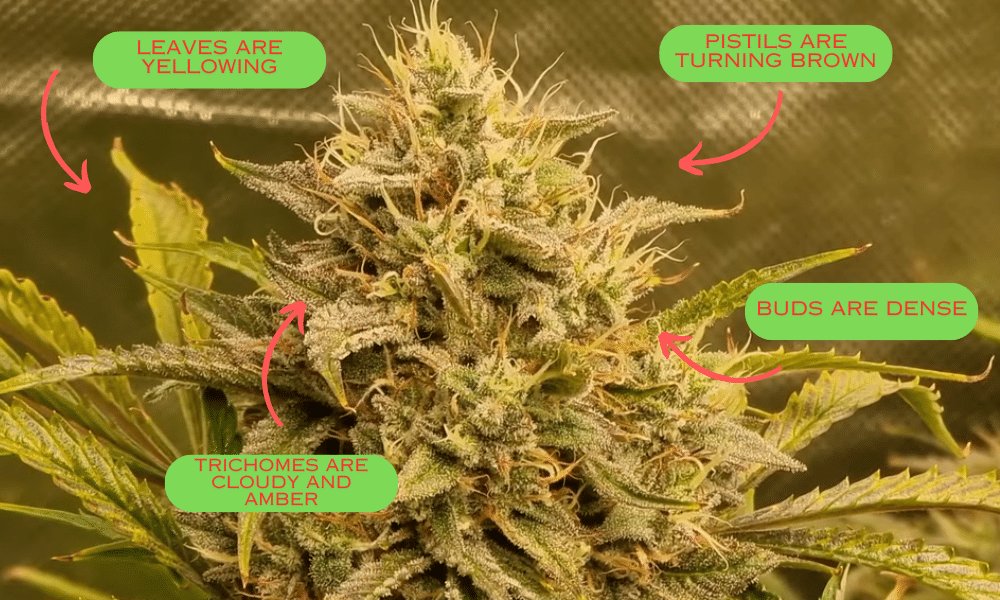
Other ways to know when your autoflower is done growing are:
- Peak aroma season: You can tell when your autoflower is ready to harvest by the heavy saturation of its aroma.
- The seed breeder’s recommendation: Reading seed reviews eliminates most of the guesswork involved with knowing the best time to harvest autoflower seeds.
- Lower watering needs: The closer your autoflower gets to being done growing, the lower its watering needs. If your growth substrate stays wet for a day or two after watering, your autoflower is probably ready for harvest.
- When the pistils are brown:If you notice the pistils on your plants turning brown, it’s a clear sign that harvest time is approaching. Note that for some strains, pistils may never turn brown. Therefore, while observing pistil color can provide a helpful hint, it’s not always a 100% verified sign of knowing when to harvest.
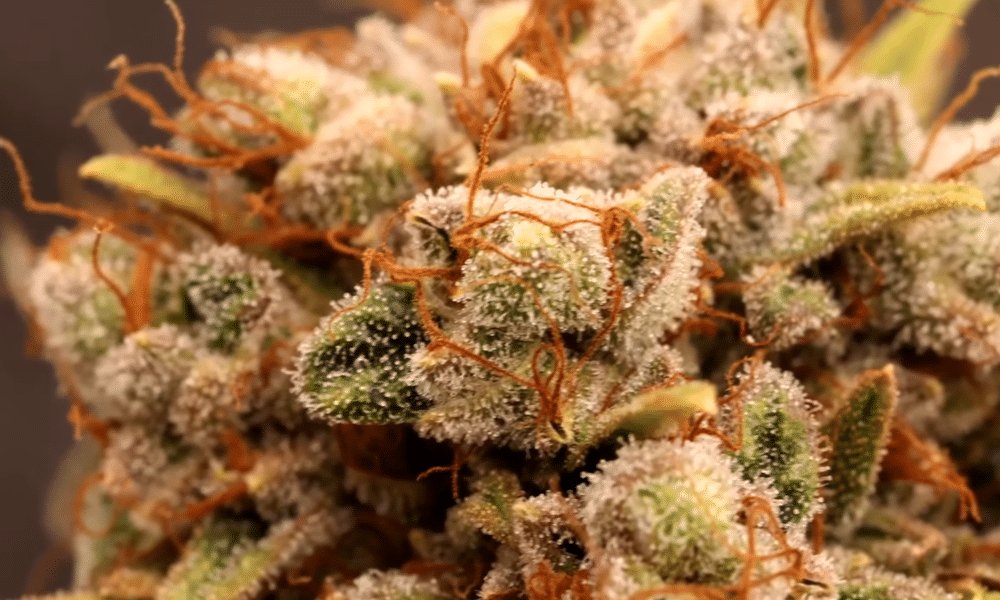
Please note: It is not uncommon to find some autoflower buds maturing earlier than others. Most times, the top buds become ripe earlier than the lower ones.
If you notice this in your autoflower grow, apply progressive harvesting to enable you to harvest all buds at their peak harvest time.
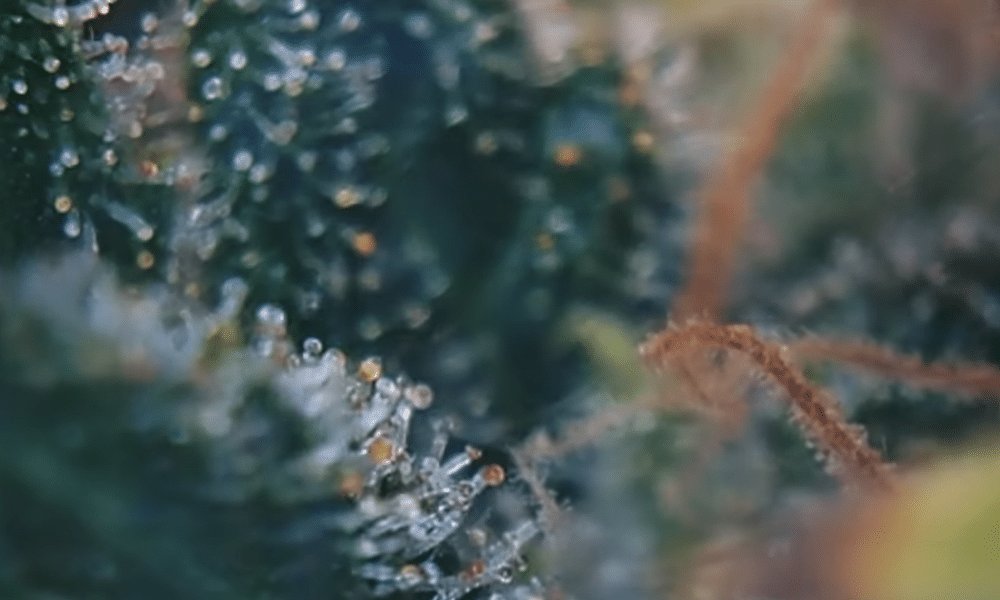
When to Harvest Autoflowers Outdoors
Growing or deciding when to harvest autoflowers outdoors is a bit more complicated. When growing autoflowers outdoors, you are, for the most part, at the mercy of nature. Thus, plan your cultivation schedule according to the seasons.
Some autoflower growers prefer to plant their autoflower seeds in the spring, so their autoflowers finish their growth cycle by June or July; right before the extreme heat or frost begins.
But again, before harvesting autoflowers, even outdoors, check for the signs that tell your autoflower is really ready for harvest so you do not leave profits on the field.
10 Harvesting Mistakes that Every Newbie Makes
It is sad to know that some cannabis growers make it through germination, the vegetative, pre-flowering, and flowering phases, only to ruin all that work at harvest time. When harvesting autoflowers, there are some best practices many cannabis growers ignore or are unaware of, leading to these 10 harvesting mistakes most newbie growers make at harvest time:
Cutting autoflower branches too small
The essence of the post-harvest stage (curing and drying) is the gradual processing activity that enhances the flavors and smoothness of the flowers. However, some autoflower growers make the harvesting mistake of cutting their autoflower branches too small to help them dry faster: a massive error that damages the flavor and smoke quality of the buds.
Using the wrong tools
When harvesting autoflowers, you want to keep the integrity of the buds as best as possible for appearance and yield quality. Thus, do not use plain scissors, razors, or other materials that won’t give a clean cut. Instead, choose a pair of sterile shears and nitrile gloves when harvesting autoflowers to avoid shaving off the trichomes.
Using paper bags as storage containers
Paper bags may work for drying autoflowers. But do not store marijuana seeds in paper bags. Using paper bags to store marijuana seeds will cause your seeds to degrade faster and could reduce their germination rate.
Not preparing enough
Scaling through the cultivation process isn’t enough to get you the profits or rewards you want. Not preparing the right tools, equipment, and materials for the next phase of your autoflowers’ journey could also lead to poor-quality nugs through delayed harvest, poor storage facility, or poor harvest techniques.
Harvesting too early
It is important to note when to harvest autoflowers so you do not leave profits and gains on the field. Your autoflower gains the most bud yields towards the final weeks of its lifecycle: towards harvest time.
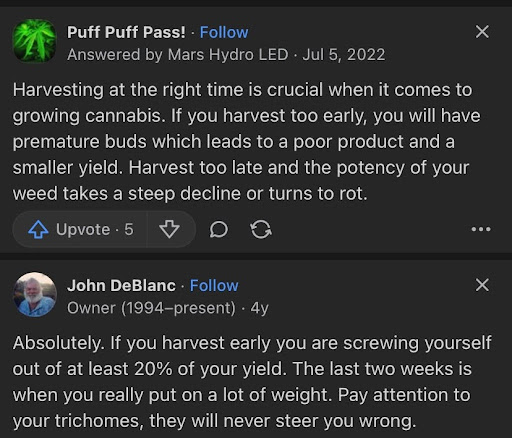
Harvesting too late
Keeping your autoflowers too long on the field or harvesting your autoflowers too late mostly leads to lower-quality flowers. After peak harvest time, your autoflower yield quality (buds, flavors, potency, etc.) declines. Your autoflower may even turn hermie and self-pollinate if you leave it long enough on the field after its peak harvest time.
Storing buds for long-term incorrectly
When stored correctly, autoflower nugs can last for up to 8 months. But, when stored in the wrong containers for too long, the quality of your autoflower buds will decline.
Smoking too soon
The essence of drying and curing cannabis is to augment the flavors, aromas, and everything delightful of your autoflower nugs. Racing through the drying and curing process or smoking your autoflowers too early would deliver a sub-par consumer experience. You can tell when your autoflower is ready for consumption through these three methods:
- Experience: You can tell your autoflower is ready for consumption by comparing its processing time with the process of a similar, previously processed cultivar.
- Checking the stems: The stems of an adequately dried and cured autoflower will audibly snap when bent 90 degrees.
- Checking the buds: To tell if your autoflower yield is adequately dried and cured, place one of the bigger buds in a sealed air-tight bag or jar.
If the bag or jar stays dry after an hour, your autoflower is ready for smoking or consumption. You can’t tell if your autoflower nugs are adequately dried and cured by touching their surface. Cannabis plants store most of their moisture within their buds.
Note: Curing your autoflowers too long reduces their potency and flavors
Ignoring environmental factors when trimming, drying, and curing
Not maintaining the proper ambient conditions when trimming, drying, and curing your autoflower harvests could lead to quality-lowering events, such as low or high humidity, photolysis, etc.
Ignoring pre-harvest flush
Although some growers opt against flushing autoflowers before harvest, most recommend conducting a pre-harvest flush about a week before harvest to improve the flavors of your autoflower yields. If you’ve been growing organically and haven’t used many nutrients, you might be tempted to skip the pre-harvest flush. However, pre-harvest flushing for detoxification is almost always a good idea.
Autoflowering Strains with the Fastest Flowering Time
Some autoflowering strains have a short flowering time of 6 weeks or even less, with fair average autoflower yields. But, our selection of the five best autoflowering strains with the fastest flowering time comprises a list of autoflowers with relatively short flowering times and mega yields. Below is a list of our five fastest flowering autoflowering strains:
- Purple Sunset Autoflower is a balanced indica-sativa autoflowering seed with a flowering time between 6 and 10 weeks. This autoflower can grow up to 1.2 meters tall (47 inches) and typically yields over 400 grams per square meter indoors and over 400 grams per plant outdoors.
- Chocolate chunk Autoflower is an Indica-dominant autoflowering seed with a short flowering time of about 7 to 9 weeks. This autoflower can grow as tall as 1.2 inches (48 inches) with indoor yields of about 400 grams per square meter indoors and outdoor yields of about 400 grams per plant.
- Lowryder Autoflower by The Seed Fair is a balanced indica-sativa hybrid with a complete harvest time of 7 to 9 weeks. The evenly balanced hybrid can grow up to a height of about 36 inches and produces indoor yields of about 200 grams per square meter and outdoor yields of about 300 grams per plant.
- Skunk Autoflower by The Seed Fair is a balanced Indica-dominant hybrid that takes 13 weeks to grow but has a flowering time of 8 weeks. This autoflower can grow up to 1.2 m tall and produce yields of about 500 grams per square meter indoors and about 150 grams per plant outdoors.
- Blue Amnesia Autoflower is a sativa-dominant hybrid cultivar that takes about 8 to 10 weeks to grow. This autoflower can get up to 1.5 m tall outdoors and produce yields of about 250 grams per square meter indoors and about 150 grams per plant outdoors.
Conclusion
A surprise harvest is very possible with autoflowers. Unless you’ve kept a grow diary or calendar and have been carefully monitoring the age signs of your autoflower nearing harvest time, you are prone to either miss your peak autoflower harvest time or make one of the ten common harvesting mistakes.
When growing autoflowers, monitor and observe your autoflower growth pattern. Doing so will not only help you tell when your autoflower is almost ready for harvest, it will help you note what factors need to be adjusted and when early.
FAQ
What happens if you let an autoflower keep growing?
If you let an autoflower keep growing beyond peak harvest time, yields will gradually begin to decline; buds will be soft and brown, THC might turn to CBN, etc.
How many weeks do autoflowers flower?
Some autoflowers take less than 6 weeks to flower; others take longer. The number of weeks your autoflower flower depends on its genetics amidst other factors.
Does darkness before harvest increase THC production in autoflowers?
Some reports note that darkness before harvest increases trichome production and in turn THC production. However scientific studies on this are limited.


